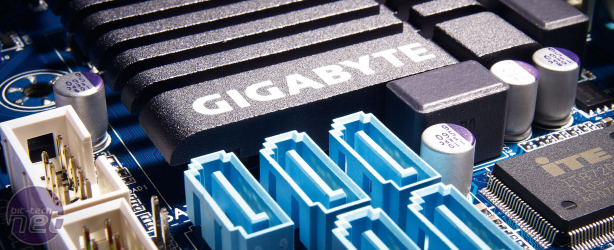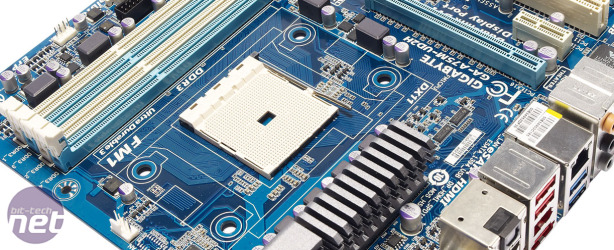Performance Analysis
The UD2H provided close competition for our current favourite FM1 board, the MSI A75MA-G55 in our Media Benchmarks. The two boards were never more than a few points apart throughout all three tests, making their overall scores very close. In the end the MSI board snuck ahead with 1,072 points to the UD2H’s 1,068, although such a close result was to be expected, as both boards are based on the same chipset.Gaming performance was also very close, with both boards returning a minimum frame rate of 37fps in Left 4 Dead 2 at 1,680 x 1,050 with no AA. The UD2H’s average frame rate was 3fps faster than that of the MSI, however, and it was comfortably faster than the MSI in our Call of Duty: Black Ops test too.
An often overlooked but important aspect of a board’s performance is SATA read and write speeds. In this area, the honours were again divided, with the UD2H achieving a faster write speed while the MSI managed the faster read speed.
With the stock-speed testing complete, we tried to overclock the UD2H. Overclocking an FM1 board can be either irrelevant or very useful, depending on how you want to use it. If you’re building a media PC, for example, overclocking isn’t useful and you shouldn’t spend loads of cash on a board with fancy overclocking features. If you’re trying to build a general-use PC, however, you’ll want to get the most performance for your money, which means that overclocking is more important.
The UD2H is clearly intended for the latter, and it impressed us when overclocking. It’s the first FM1 board we’ve seen that can lower the CPU multiplier, for example, enabling us to push the reference clock higher while maintaining the overall CPU frequency.
After a little tinkering we found that the UD2H could run stably with a reference clock of 135MHz; this is an excellent result, and well above the 117MHz maximum that the MSI could manage. We didn’t benchmark the system at these settings though, as using a 135MHz reference clock left us between memory dividers on the UD2H – we’d have had to choose from 1,440MHz (well below our memory’s rated 1,600MHz) or 1,798MHz (well above it).
We therefore dropped the reference clock to 125MHz and increased the CPU multiplier to 28x, for an overall CPU frequency of 3.5GHz, giving us a more manageable memory speed of 1,666MHz and a GPU frequency of 750MHz. To keep this overclock stable, we had to push 1.55V through the CPU, apply 1.2V to the CPU NB, put 1.325V through the APU VDDP and give 1.2V to the Southbridge.
These settings delivered a leap in performance. The overall Media Benchmarks score jumped to 1,277 (a 20 per cent improvement), edging out the MSI. Gaming performance was also excellent – we saw an 11fps boost in our minimum frame rates in Left 4 Dead 2.
Conclusion
The Gigabyte GA-A75M-UD2H is an impressive beast. Its performance at stock speed was solid, with slightly higher frame rates in games than we’ve seen elsewhere. It’s a potent overclocker too, with the best performance we’ve seen from an FM1 board.This comes at a price, though – the UD2H costs £11 more than the MSI A75MA-G55, a board that keeps up with the UD2H fairly well. The MSI also offers rotated SATA ports and the same USB 3 ports as the UD2H, so it’s more than a match when it comes to features. However, considering the budget nature of AMD’s FM1 platform, squeezing extra performance from the APU is a valuable addition. As the UD2H is the best board for overclocking an FM1 processor, it justifies its higher price, although the MSI remains a solid choice if saving money is more important than squeezing the absolute maximum performance from your PC.

-
Value19 / 25
-
Features21 / 30
-
Speed40 / 45


MSI MPG Velox 100R Chassis Review
October 14 2021 | 15:04











Want to comment? Please log in.